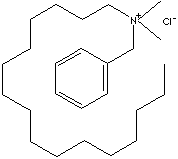| CAS
NO. |
122-18-9 |

|
| EINECS
NO. |
204-526-3 |
| FORMULA |
CH3(CH2)15N(CH3)2CH2C6H5.Cl |
| MOL
WT. |
396.10 |
|
H.S.
CODE
|
|
|
PRICE |
|
|
TOXICITY
|
|
| SYNONYMS |
Cetalkonium chloride;
|
| N-hexadecyl-N,N-dimethyl
Benzenemethaminium, Chloride;
cloruro de cetalconio;
Chlorure de cetalkonium
Benzyldimethylhexadecylammonium chloride; Benzyl
n-hexadecyl dimethylammonium chloride; Cetol; Benzyldimethylhexadecylammonium
chloride, hydrate;
N-Hexadecyl-N,N-dimethylbenzenemethanaminium chloride; Alkyl C-16 benzyldimethyl
ammonium chloride;
|
|
CLASSIFICATION
|
|
|
PHYSICAL
AND CHEMICAL PROPERTIES
|
| PHYSICAL
STATE |
white to creamy crystalline powder |
|
MELTING
POINT
|
54
- 58 C |
| BOILING
POINT |
|
| SPECIFIC
GRAVITY |
|
|
SOLUBILITY
IN WATER
|
Freely
soluble
|
| pH |
6.0
- 8.5 (10% sol.)
|
| VAPOR
DENSITY |
|
|
REFRACTIVE
INDEX
|
|
|
NFPA
RATINGS
|
Health:
2, Flammability: 2, Reactivity: 0
|
|
AUTOIGNITION
|
|
| FLASH
POINT |
|
| STABILITY |
Stable
under ordinary conditions |
|
GENERAL
DESCRIPTION & APPLICATIONS
|
Quaternary ammonium compounds are any of a group of ammonium salts in which
organic radicals have been substituted for all four hydrogens of the original
ammonium cation. They has a central nitrogen atom which is joined to four
organic radicals and one acid radical. The organic radicals may be alkyl, aryl,
or aralkyl, and the nitrogen can be part of a ring system. They are prepared by
treatment of an amine with an alkylating agent. They show a variety of physical,
chemical, and biological properties and most compounds are soluble in water and
strong electrolytes. Such compounds include
- Benzalkonium
Chloride ( CAS RN: 8001-54-5)
- Benzethonium Chloride CAS
121-54-0
- Cetalkonium Chloride( CAS
122-18-9)
- Cetrimide ( CAS 8044-71-1)
- Cetrimonium Bromide
( CAS 57-09-0)
- Cetylpyridinium Chloride
(CAS 123-03-5)
- Stearalkonium Chloride
( CAS 122-19-0)
They have properties of
disrupting micro-organisms' cell processes and surfactants. These compounds are
used as
- Active Ingredient for
Conditioners
- Antistatic Agent
- Detergent Sanitisers
- Softner
for textiles and paper products
- Phase
Transfer Catalyst
- Antimicrobials
- Disinfection Agents And
Sanitizers
- Slimicidal Agents
- Algaecide
- Emulsifying Agents
- Pigment Dispersers
|
| SALES
SPECIFICATION |
|
50%
|
|
APPEARANCE
|
Clear
to light-straw colored liquid
|
| CONTENT |
49.0%
min
|
|
ETHANOL
+ WATER
|
Balance
|
|
COLOR,
APHA
|
150
max
|
|
FREE
AMINE
|
2.0%
max
|
| TRANSPORTATION |
| PACKING |
200kgs
in drum |
| HAZARD
CLASS |
9
(Packing group III)
|
| UN
NO. |
3077
|
| OTHER
INFORMATION |
|
Hazard Symbols: XI N, Risk Phrases: 36/37/38-50/53, Safety Phrases:
61 |
|
GENERAL DESCRIPTION OF DISINFECTANT |
Disinfectant is
an agent applied to inanimate objects to destroy, neutralize, or inhibit the
growth of disease-carrying microorganisms, (whereas antiseptics are applied
primarily to living things). Heat and radiation are also disinfectants. Common
ingredients of chemical disinfectant are:
- Mercuric
Chlorides
- Formaldehyde
- 8-Hydroxyquinoline
- Copper
Hydroxide
- Cresol
- Alcohols
(Ethyl Alcohol; Isopropyl Alcohol)
- Iodines /
Iodophors
- Chlorine
releasing compounds
- Gluteraldehyde
- Phenolics
- Quaternary
Ammonium Compounds
|
|
PRICE |
|

|
